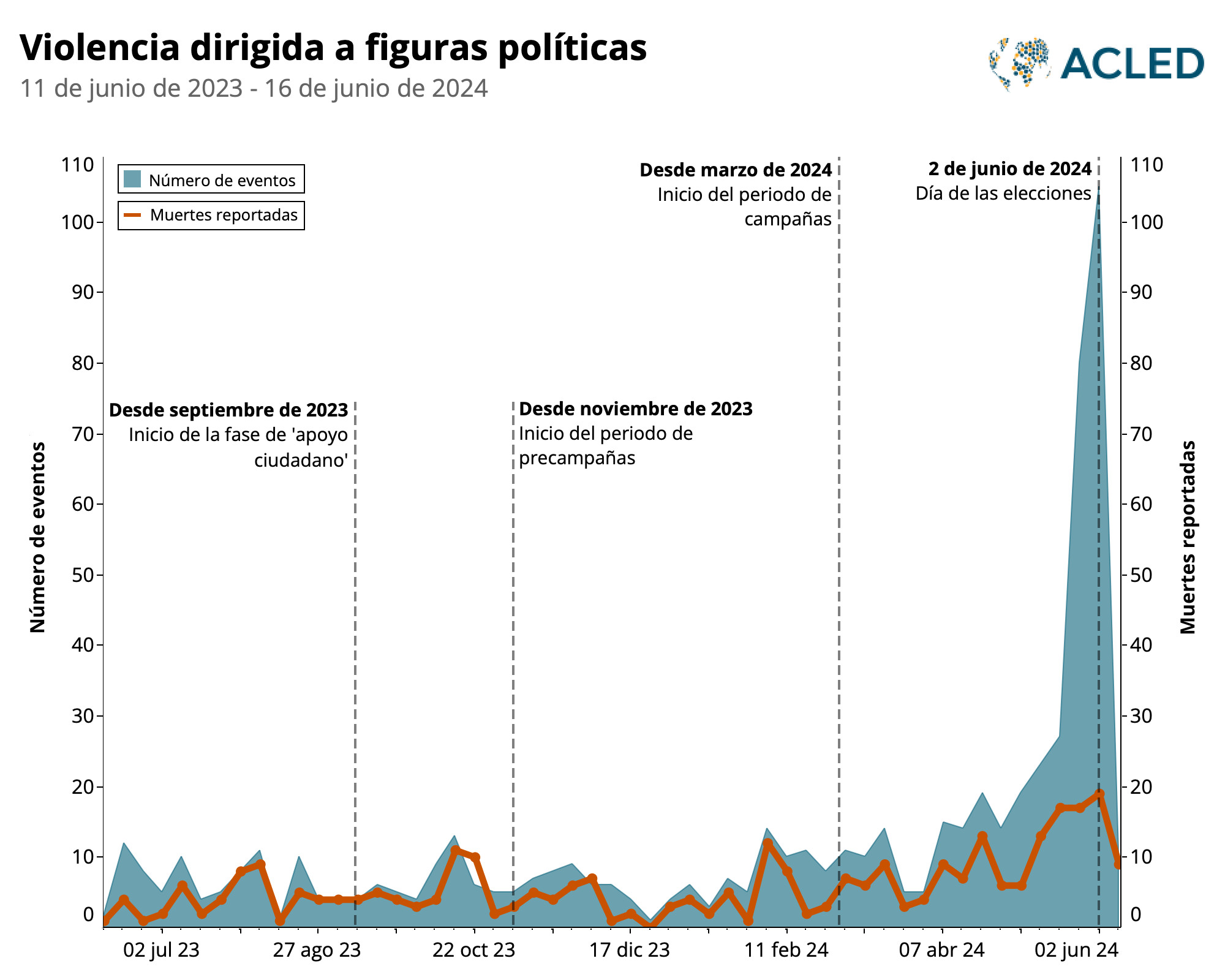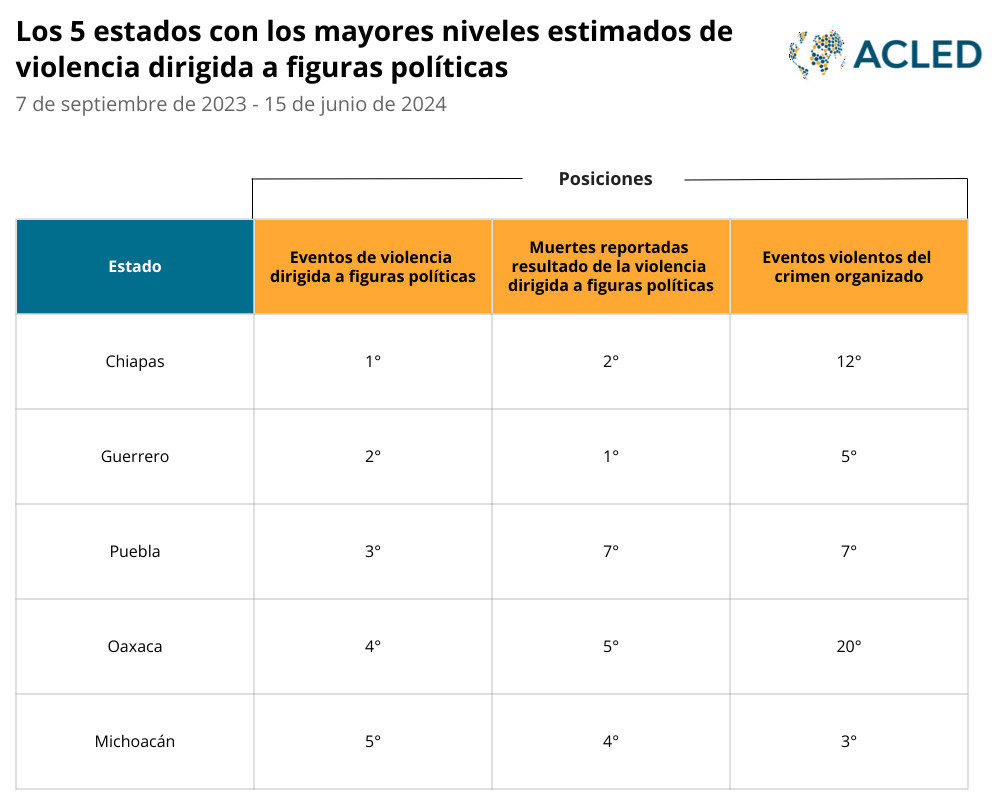On June 2nd, Claudia Sheinbaum, the candidate from the ruling MORENA party (Movimiento de Regeneración Nacional), secured a landslide victory in the presidential election with nearly 60% of the vote. This historic win makes her the first woman president of Mexico. The presidential election coincided with legislative, state, and municipal elections across the country. However, the electoral process was marred by significant violence, including assassinations and attacks targeting candidates and political figures. The Armed Conflict Location & Event Data Project (ACLED) documented over 330 incidents of violence against political figures during the campaign period, from the start of the federal campaign on March 1st to election day on June 2nd. Tragically, at least 95 of these incidents resulted in fatalities. The 2024 election campaign witnessed an unprecedented level of violence, surpassing the levels recorded in the 2018 and 2021 general and federal elections, which saw 254 and 257 events, respectively.
The heightened violence during the 2024 campaign also impacted candidates who were not direct targets. Over 553 candidates requested state protection due to threats, while others withdrew from the race altogether due to intimidation. Despite the severity of the violence, none of the leading presidential candidates presented substantial proposals to address this critical issue.
This analysis explores the key trends emerging from the 2024 Mexican election cycle:
- Violent attacks are overwhelmingly concentrated at the local level: Over 80% of the attacks targeting candidates, their supporters, or families involved candidates running for local positions.
- Perpetrators relentlessly pressure local authorities: Current and former officials not seeking re-election were targeted in over 40% of violent events.
- Violence against political figures extends beyond the campaign period: While violence intensifies during campaigns, it begins rising early in the electoral cycle and continues well past election day.
- Organized crime group competition is a major driver of violence: Six of the ten states with the highest rates of violence against political figures are also among the ten most affected by organized crime violence.
- Competition among local power brokers is also a significant source of violence: Less lethal forms of unrest, such as riots and property destruction, account for roughly 30% of events, indicating that local power struggles and community grievances over election irregularities or results also trigger violence.
Local Elections: The Epicenter of Violence
Approximately 40% of violent events targeting political figures during the 2024 election cycle were directed at candidates running for office. Although local, state, and federal elections were held concurrently, over 80% of the 216 violent incidents against candidates, their families, or supporters targeted political figures competing for local positions, including mayoralties and municipal councils. The remaining 20% included attacks against candidates for federal office and former candidates.
Veracruz provides a compelling example of how local elections can fuel violence. Unlike most federal entities that held municipal elections in 2024, Veracruz will hold these elections in 2025. During the last municipal elections in 2021, Veracruz experienced the highest level of violence against political figures, with 57 events recorded in the six months leading up to the vote and the two weeks following. However, in 2024, ACLED recorded about a quarter of the 2021 figure—17 events—in Veracruz, dropping it to tenth place in the rankings (see graph below). This significant shift in violence levels highlights how the absence of municipal elections can correlate with lower levels of violence.
 Combined chart – Violence targeting political figures 11 June 2023 to 16 June 2024 – Spanish
Combined chart – Violence targeting political figures 11 June 2023 to 16 June 2024 – Spanish
Image alt text: Trend chart depicting violence against political figures in Mexico from June 2023 to June 2024, showing peaks during pre-campaign, campaign, and election periods, with detailed monthly data points.
In other states, the presence of local elections also resulted in high levels of violence against officials, functionaries, and candidates due to intense competition for power. A large number of candidates running for local office were targeted by organized crime groups and political rivals. Candidates were particularly vulnerable in the states of Hidalgo, Mexico, Morelos, and Puebla, where they represented the majority of victims. However, attacks against candidates were most lethal in Chiapas and Guerrero, where 21 and 20 individuals, respectively, were killed in violent incidents involving candidates.
Although on a smaller scale, elections for state-level officials, such as governors and local deputies, also contributed to the violence. Several candidates for local congresses were targeted during this election cycle, particularly in states holding gubernatorial elections. In Chiapas and Morelos, armed men attacked two state senate candidates from the Fuerza y Corazón por México coalition, while in Veracruz, armed men fatally shot a MORENA candidate for local deputy. These instances indicate that while municipal elections are a significant trigger for political violence, major state-level contests can also contribute to the violence observed in 2024.
Of all incidents recorded since the start of the electoral process, at least 69 were committed against women, many of whom were candidates for public office, representing 13% of the violence. However, this should not be interpreted as women being less likely to be targeted. Despite the 2024 elections being notable for women’s candidacies for president, Claudia Sheinbaum’s subsequent victory, and the National Electoral Institute’s guidelines for parties to ensure gender parity in candidacies, women remain underrepresented in local official bodies. In 2023, only 28% of local positions were held by women. In fact, female candidates received more threats than men during the 2024 electoral process, often forcing them to withdraw from the race, as was the case for 217 female candidates in Zacatecas alone.
Relentless Pressure on Local Authorities
Candidates were not the only political figures exposed to violence in the recent election cycle. Over 40% of the 540 incidents of violence targeted current and former officials not running for election, such as mayors and public servants. The persistence of violence against these officials indicates an intent to exert pressure on political processes beyond election periods.
ACLED data reveals that public officials across different sectors are affected. Officials dealing with judicial and security matters and public administration treasurers were the most frequently targeted non-elected officials. This trend is largely attributed to organized crime groups’ interest in controlling local resources and key administrative areas, such as security and judiciary, that can impact their operations. Indeed, non-running public officials are targeted nationwide, but they represent a higher proportion of victims in states heavily affected by organized crime-related violence, such as Guanajuato, Guerrero, and Michoacán.
Family members of politicians were also victims in approximately 14% of attacks against politicians, either as direct targets or related casualties. Often, violence against family members reflects an intention to pressure a political figure. For example, in October 2023, alleged members of the Jalisco New Generation Cartel (CJNG) attempted to assassinate the brother of the mayor of Tacámbaro—himself a former mayor—after the group issued threats against him and his treasurer. In at least 28% of these cases, the family members attacked were also public officials or politicians, highlighting that a few families concentrate significant political power but are not spared from attacks, particularly in states like Guerrero, Michoacán, and Puebla.
A notable example is the influential Salgado family in Guerrero state. Several members of the Salgado family hold elected positions and have been targets of threats and attacks in recent years. In August 2023, Zulma Carvajal Salgado—cousin of the governor of Guerrero, Evelyn Salgado Pineda, who succeeded her father, Félix Salgado Macedonio—was attacked, resulting in the death of her husband. The attack occurred shortly after she announced her intention to run for municipal office in Iguala.
Violence Beyond Campaign Season
Similar to previous electoral processes, pre-election unrest, particularly violence against political figures, began escalating even before campaigns officially commenced. Violence against political figures saw an initial spike in October 2023, shortly after the start of a period called citizen support, which began on September 9, 2023, in some states. During this period, aspiring candidates for president, senate, and federal councils gather signatures to run as independent candidates. After a relatively consistent level between November 2023 and January 2024, violent events against political figures increased substantially in February (see graph below). This rise coincided with the end of the pre-campaign period in most states, when aspiring candidates from political parties conduct public activities to garner support for their nominations.
It is once candidacies are defined, however, that violence against political figures skyrockets, as the targets of those seeking to influence contests through violent means become more identifiable. From the start of the campaign for federal and state elections in March and local elections in April, violence against political figures increased exponentially, reaching a peak of 132 events in May, resulting in 55 fatalities and marking a record in both figures since ACLED began covering the country in 2018. Election Day itself experienced the highest number of events against political figures, with 80 events recorded.
However, risks for political figures are unlikely to cease after elections. In Guanajuato, for example, armed men attacked the business of the elected mayor of Tarimoro days after he won the election. Furthermore, past election cycles suggest that violence will not only remain high at least until the inauguration ceremonies but will continue throughout the new administrations. ACLED recorded 210 and 179 events in the six months following the 2018 and 2021 elections, respectively, as well as consistent levels of violence over the years, totaling nearly 3,000 events of violence against political figures since ACLED began its coverage.
Organized Crime Competition: A Key Driver
ACLED records high levels of violence against political figures in the states of Guanajuato and Michoacán, two of the federal entities most affected by organized crime violence in the year prior to the 2024 vote, confirming that in some states, competition between criminal groups drives violence against political figures. Six of the ten states with the highest levels of incidents against political figures during the election cycle are also among the ten most affected by organized crime-related violence in the same period (see map below). This is particularly true for Guerrero, which ranks second in the number of violent incidents against political figures, but first in the number of fatalities in these attacks, and fifth in violence likely related to organized crime during the electoral cycle (see table below). In Chiapas, the state with the highest levels of violence against political figures during this electoral process, increased violence linked to the rivalry between CJNG and the Sinaloa cartel contributed to a more than 90% increase in violence against political figures compared to the 2021 election cycle. High levels of violence led to the cancellation of voting in Chicomuselo and Pantelhó.
 Table – Top 5 Mexican states with highest estimated levels of violence targeting political figures – 7 Sept 2023 – 15 June 2024 – Spanish
Table – Top 5 Mexican states with highest estimated levels of violence targeting political figures – 7 Sept 2023 – 15 June 2024 – Spanish
Image alt text: Table ranking the top 5 Mexican states with the highest estimated levels of violence targeting political figures during the 2024 election cycle, specifying state names, event counts, and fatality numbers for comparative analysis.
However, there are exceptions, particularly when one organized crime group exerts hegemony. In fact, the states of Jalisco and Sinaloa are among the ten most affected by organized crime violence, but not among those with the most events of violence against political figures. They are also, respectively, the strongholds of the CJNG and the Sinaloa cartel, suggesting that their influence in local politics may be so strong that they do not need to resort to violence against political figures to consolidate their power. Much of the violence recorded in these states, in fact, stems from these groups’ tactics to exert territorial control and may occasionally be related to localized disputes with smaller groups, such as in the case of violence involving the Nueva Plaza cartel in the Tlajomulco area.
However, in some cases, the presence of a strong political establishment dominated by a few families also contributes to low levels of violence against political figures. Nuevo León is an example of this. Despite recording some of the highest levels of organized crime violence, violent incidents against political figures have remained limited in the past year. Nuevo León is the second wealthiest state in the country, with an economy led by export-oriented manufacturing. A small number of families concentrate most of the wealth and political power. The main candidates for governor in the 2021 elections, some of whom are part of these families, have been accused of links to criminal organizations such as Los Zetas and the Gulf Cartel (CDG). Furthermore, since the collapse of the Institutional Revolutionary Party (PRI) hegemony in the 1990s, the state has been governed by the Citizen Movement or independent candidates, but MORENA has failed to make significant advances in the state’s political sphere. In the recent elections, in fact, it only won two of the 51 municipalities in the state.
Local Power Struggles Fuel Violence
Beyond direct attacks against political figures, a significant portion—30%—of incidents manifested as riots and property destruction. These events were linked to expressions of public discontent toward local representatives or rivalries between competing political actors. They were particularly prominent in Chiapas, Puebla, and Hidalgo (see graph below). These three states are more susceptible to local power struggles and electoral disputes due to pre-existing inter-community conflicts and the concentration of power in the hands of local power brokers or caciques.
Before election campaigns began, this form of violence primarily erupted during protests where demonstrators confronted representatives for failing to meet their demands. However, property destruction and collective violence can also be used by political contenders to intimidate their adversaries. Indeed, these events notably increased during the election campaign in April and May and included attacks against the properties of candidates and officials, and collective actions against supporters of a rival faction. For example, on May 15, in Tlanchinol, Hidalgo, armed men shot at a vehicle parked in front of the house of a candidate seeking to join the municipal council for the MORENA-PANAL alliance, who had already reported receiving threats before the election.
Finally, unrest surrounding election day is often related to the rejection of results or allegations of irregularities or vote-buying during the process by a candidate. For example, on June 1, in Puebla, a group of 200 people, including supporters of the PRI and the National Action Party (PAN), physically assaulted MORENA members in Venustiano Carranza over alleged vote-buying. Due to the incident, the State Electoral Institute decided to annul the election results due to irregularities. Similarly, in Chenalhó, Chiapas, supporters of the Green Party of Mexico clashed during an assembly to elect their representatives amid allegations that the unrest was orchestrated by the mayor to prevent his candidate from losing.
